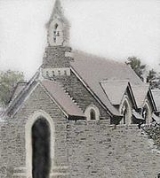
Julius and Aaron
Encyclopedia
Saints Julius and Aaron are celebrated as two British
martyr
s who died during the religious persecutions of the Emperor Diocletian
in AD 304. Their feast day was traditionally celebrated on July 1.
In his De Excidio et Conquestu Britanniae
, Gildas
writes: "God…..in the…..time of persecution…..lest Britain should be completely enveloped in the thick darkness of black night, kindled for us bright lamps of holy martyrs…..I speak of Saint Alban
of Verulamium
, Aaron and Julius, citizens of Caerleon
, and the rest of both sexes in different places, who stood firm with lofty nobleness of mind in Christ's battle."
There is doubt that Diocletian's persecutions were ever carried out in Britain, but churches were nevertheless dedicated to these two saints. Giraldus Cambrensis
confirms that two churches at Caerleon were dedicated to Aaron and Julius. Bede
repeats Gildas' words, but mistranslated Gildas' Urbs Legionum as Chester
rather than Caerleon.
They were martyred at Caerleon and the approximate sites of their martyrdom are well known locally. Many churches in Caerleon and the wider Newport
area are dedicated to them, as well as the suburb of St. Julian's
.
United Kingdom
The United Kingdom of Great Britain and Northern IrelandIn the United Kingdom and Dependencies, other languages have been officially recognised as legitimate autochthonous languages under the European Charter for Regional or Minority Languages...
martyr
Martyr
A martyr is somebody who suffers persecution and death for refusing to renounce, or accept, a belief or cause, usually religious.-Meaning:...
s who died during the religious persecutions of the Emperor Diocletian
Diocletian
Diocletian |latinized]] upon his accession to Diocletian . c. 22 December 244 – 3 December 311), was a Roman Emperor from 284 to 305....
in AD 304. Their feast day was traditionally celebrated on July 1.
In his De Excidio et Conquestu Britanniae
De Excidio et Conquestu Britanniae
De Excidio et Conquestu Britanniae is a work by the 6th-century British cleric Gildas. It is a sermon in three parts condemning the acts of Gildas' contemporaries, both secular and religious, whom he blames for the dire state of affairs in sub-Roman Britain...
, Gildas
Gildas
Gildas was a 6th-century British cleric. He is one of the best-documented figures of the Christian church in the British Isles during this period. His renowned learning and literary style earned him the designation Gildas Sapiens...
writes: "God…..in the…..time of persecution…..lest Britain should be completely enveloped in the thick darkness of black night, kindled for us bright lamps of holy martyrs…..I speak of Saint Alban
Saint Alban
Saint Alban was the first British Christian martyr. Along with his fellow saints Julius and Aaron, Alban is one of three martyrs remembered from Roman Britain. Alban is listed in the Church of England calendar for 22 June and he continues to be venerated in the Anglican, Catholic, and Orthodox...
of Verulamium
Verulamium
Verulamium was an ancient town in Roman Britain. It was sited in the southwest of the modern city of St Albans in Hertfordshire, Great Britain. A large portion of the Roman city remains unexcavated, being now park and agricultural land, though much has been built upon...
, Aaron and Julius, citizens of Caerleon
Caerleon
Caerleon is a suburban village and community, situated on the River Usk in the northern outskirts of the city of Newport, South Wales. Caerleon is a site of archaeological importance, being the site of a notable Roman legionary fortress, Isca Augusta, and an Iron Age hill fort...
, and the rest of both sexes in different places, who stood firm with lofty nobleness of mind in Christ's battle."
There is doubt that Diocletian's persecutions were ever carried out in Britain, but churches were nevertheless dedicated to these two saints. Giraldus Cambrensis
Giraldus Cambrensis
Gerald of Wales , also known as Gerallt Gymro in Welsh or Giraldus Cambrensis in Latin, archdeacon of Brecon, was a medieval clergyman and chronicler of his times...
confirms that two churches at Caerleon were dedicated to Aaron and Julius. Bede
Bede
Bede , also referred to as Saint Bede or the Venerable Bede , was a monk at the Northumbrian monastery of Saint Peter at Monkwearmouth, today part of Sunderland, England, and of its companion monastery, Saint Paul's, in modern Jarrow , both in the Kingdom of Northumbria...
repeats Gildas' words, but mistranslated Gildas' Urbs Legionum as Chester
Chester
Chester is a city in Cheshire, England. Lying on the River Dee, close to the border with Wales, it is home to 77,040 inhabitants, and is the largest and most populous settlement of the wider unitary authority area of Cheshire West and Chester, which had a population of 328,100 according to the...
rather than Caerleon.
They were martyred at Caerleon and the approximate sites of their martyrdom are well known locally. Many churches in Caerleon and the wider Newport
Newport
Newport is a city and unitary authority area in Wales. Standing on the banks of the River Usk, it is located about east of Cardiff and is the largest urban area within the historic county boundaries of Monmouthshire and the preserved county of Gwent...
area are dedicated to them, as well as the suburb of St. Julian's
St. Julian's, Newport
St Julians is an electoral district and coterminous community of the City of Newport, South Wales.The ward is bounded by the River Usk to the west and north, The Moorings, Badminton Road, Reynolds Close, Rembrandt Way, Constable Drive, Heather Road, Kelly Road, Merlin Crescent, Avalon Drive,...
.

